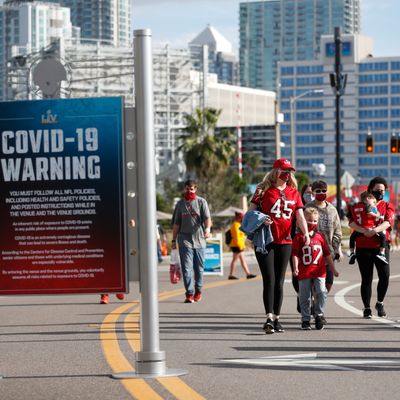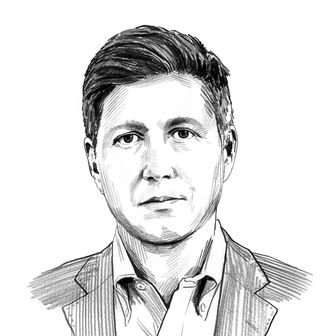
For an event so titanically important to the sports-industrial capitalist complex — and thus as tightly choreographed as a Cirque du Soleil set change — the Super Bowl sure does tend to play host to some weird shit. Whether it’s Janet Jackson’s nipple, Bruce Springsteen’s crotch slide, a player doing cocaine on the sidelines, Left Shark, or the 2013 game when the lights suddenly went out (leading to an incredible near comeback, post–power outage, orchestrated by a promising young quarterback named Colin Kaepernick), the big game has a way of going off-script.
And the strangeness quotient this year may be higher than ever, because nothing can really prepare the league for the first Pandemic Super Bowl. (Ok, technically this isn’t quite true; epidemiologists in fact argued that last year’s comeback win by Kansas City over San Francisco avoided a superspreader event in northern California by precluding the need for a Bay Area parade.) Every single move the NFL made this season has been with an eye toward this date and making sure the Super Bowl goes off as planned. With just one game left, it’s close to fulfilling that goal. But not every concern has been accounted for, and the potential for some kind of disruption — or at least distraction — is high. Here are the big question marks going into the game.
Can they avoid a Justin Turner disaster?
In case you don’t remember, Justin Turner was the Los Angeles Dodgers third baseman who was mysteriously pulled from the lineup midway through Game Six of the World Series. It turned out that he’d received a positive test for COVID-19 in the middle of the game and had immediately been hustled into isolation. Major League Baseball dodged a huge bullet when the Dodgers won Game Six, ending the Series. Had Tampa Bay forced a Game Seven, a huge question would have loomed: When would the game have been played? Would the Dodgers have been contact-traced to the point of a week-long postponement? Two weeks? (Turner ended up running onto the field to celebrate, maskless, with his teammates, so … YOLO, I guess.) The nightmare scenario for the NFL is a player testing positive the day before or morning of the game. Any such positive would create a contact-tracing nightmare — but what if it turns out to be Tom Brady or Patrick Mahomes? This Super Bowl would have an asterisk attached to it forever, if the league even went ahead with the game at all. What if there’s a true outbreak, like the one that upended the Baltimore Ravens’ season? Tightened NFL protocols have made this less likely, but Major League Baseball hadn’t seen a positive test in two months until Turner’s; COVID-19 has a way of popping up at incredibly inconvenient times. Suffice it to say, NFL brass will breathe much easier when this game is over.
Will everyone in the stands be wearing masks? Because, you know, some of them are gonna have COVID.
The NFL is allowing 22,000 fans into the game, 7,500 of whom are vaccinated health-care workers. But that means 14,500 fans are regular people. And the league isn’t requiring them to be vaccinated, and it will not be administering tests upon entry. (The league guidelines for fans are roughly what you’d see posted on the door of your local Applebee’s.) Obviously, the Super Bowl isn’t the only sporting event in the United States that has been allowing fans — I’ve attended a few myself — but it’s certainly the highest-profile one. Yes, the risk of catching COVID outside is of a lower order of magnitude than that of catching it indoors. But broadcast shots of screaming, maskless fans will still be unsettling, and you, as a viewer, should probably prepare yourself accordingly.
What are the commercials going to look like? Can this be a normal corporate Super Bowl event?
Budweiser has already announced they won’t be advertising during the Super Bowl, a move that had the totally unanticipated side effect of getting us all to talk about Budweiser for two weeks. Nonetheless, there will still be plenty of commercials for those only watching the game for the ads anyway, including a reunion of Wayne and Garth to hawk Uber Eats. (This is the Gen X equivalent of the 1994 Super Bowl bringing back the Smothers Brothers.) But remember, the subtext to just about every one of these commercials is “Hey, here’s some stuff to enjoy at your Super Bowl party, which you are at right now, with all your friends, gathering and breathing the same air.” There are some worries that such parties will act as the next Thanksgiving-and-Christmas-like superspreader events. It feels a little weird just settling in for wacky Frito-Lay ads, doesn’t it?
What are the TV ratings going to be like?
It’s fair to say that the sports-media world has been turned upside down by the shockingly low ratings for nearly every major event during the pandemic. But it’s one thing for the Masters’ ratings to slide a little at CBS; it’s quite another if the Super Bowl’s fall off a cliff. Last year halted a five-year streak of ratings declines for the game, but considering how much lower regular-season ratings were this year than last year (though they were still respectable compared to other programming), you should expect the numbers to slip as well. How steep will the drop be? And can the NFL, and all sports really, recover in a post-pandemic world? (Whenever that is.)
Will the game be good enough to provide an escape?
This is a perfect matchup for the NFL: Patrick Mahomes, star of the present and the future, against Tom Brady, the greatest (and most hated) quarterback of all time. In a normal year, it’d be the perfect recipe for escapism. But who can escape right now? As someone who has been watching a lot of sports in an attempt to get away from the pandemic, trust me: Even if the game is thrilling, it will be hard to detach yourself from our current reality. Which leads me to …
Are we really sure about all this?
From the very beginning of play last summer, the NFL has barreled its way through this bizarre season with its usual brusqueness, shouldering away any doubts about the wisdom of going forward during COVID while gathering up every dime it possibly could. This has led to a season that was not particularly compelling and often featured shoddy on-field play, a short-term tradeoff that could cost the NFL in the long-term.
It’s one thing for college basketball, or your local high school, to take the “let’s just muddle through” approach. But with the Olympics in danger and the World Cup still nearly two years away, the Super Bowl might be the most important sporting event to take place during the pandemic. This is usually the NFL’s prime showcase for all the excess that has made the sport the truest avatar of American life and culture; now it just feels like the league is trying to salvage what revenue it can before licking its wounds and hoping things are better by next year. Look, with players like Mahomes and Brady in it, it’s possible this game will be so exciting that it transcends the pandemic entirely — that it makes you, however briefly, forget your troubles and woes. The NBA Finals and the World Series did provide some of that sensation, but they still didn’t feel anything like a “normal” version of themselves: You never forgot the weirdness of the whole enterprise. And the Super Bowl is a much vaster undertaking than either of those. There’s no “bubble,” and it involves countless moving parts: For crying out loud, there’s going to be a huge halftime show. (I hope you like The Weekend, because this is as close to live music as any of us is getting for a while. ) The Super Bowl can’t help but feel different this time around — maybe too different. By necessity, it’s going to be smaller. But the Super Bowl is never supposed to be small. And I wonder if it will feel much like a Super Bowl at all.






























